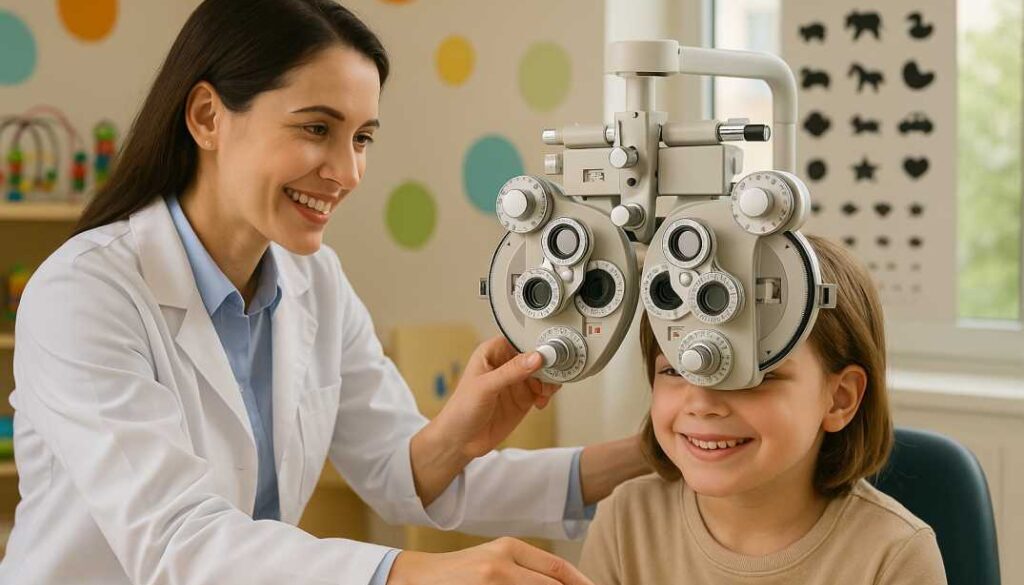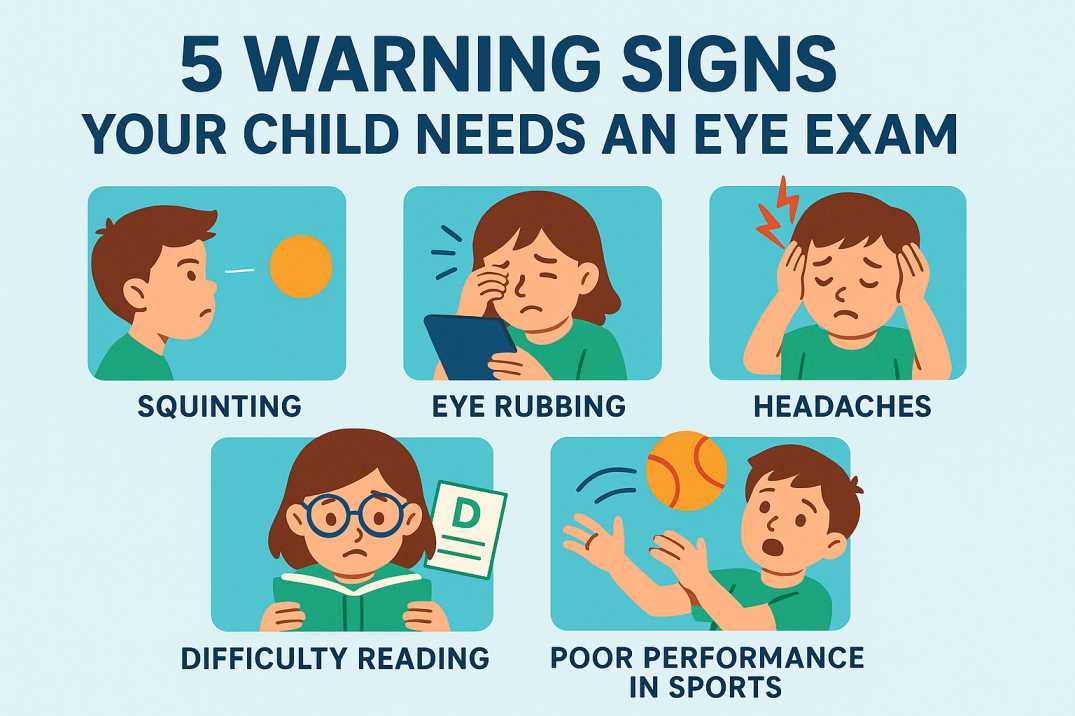Child Eye Strain & Squinting: 5 Signs Your Kid Needs Eye Exam
Quick Answer: Watch for persistent squinting, eye strain from screens, frequent headaches after visual tasks, declining grades, and poor sports coordination. These signs indicate your child may need an immediate comprehensive eye exam.
Children often can’t express vision problems, making it essential for parents to recognize warning signs like squinting, digital eye strain symptoms, frequent headaches, poor school performance, and avoidance of reading activities. Early detection through comprehensive eye exams can prevent permanent vision problems and support your child’s academic success.
As a parent, you want to give your child every advantage in life. Yet one crucial aspect of their development often goes overlooked until problems become severe: their vision. Children grow up naturally adapting to vision issues, so when they get into school and start reading and learning, that is when parents and teachers begin to notice certain problems.
Unlike adults who can articulate vision concerns, children typically don’t realize they have vision problems. Children born with poor vision may believe that’s how everyone sees, so they don’t think to speak up. This makes it essential for parents to recognize the warning signs that indicate their child may need professional eye care.
Why This Matters: Early detection and correction of visual impairments in children are essential for preventing specific developmental delays such as difficulties in learning, social interaction, and motor skills. The latest 2024 research published in the British Journal of Ophthalmology shows that myopia prevalence among children has increased dramatically – from 24.32% in 1990 to 35.81% in 2023, with projections reaching 39.80% by 2050. This means approximately 740 million children worldwide could be affected by myopia by 2050.
Common Questions Parents Ask:
- When should my child have their first eye exam?
- What are the early signs of vision problems in children?
- How can I tell if my child’s squinting is normal or concerning?
- Why is my child getting headaches after homework?
- Could my child’s poor grades be related to vision problems?
Unlike adults who can articulate vision concerns, children typically don’t realize they have vision problems. Children born with poor vision may believe that’s how everyone sees, so they don’t think to speak up. This makes it essential for parents to recognize the warning signs that indicate their child may need professional eye care.
Adaptation and Acceptance: Children are remarkably adaptable. If they’ve always seen the world in a certain way, they assume that’s normal. A child with severe nearsightedness might think everyone sees distant objects as blurry shapes.
Lack of Comparison: Unlike adults who remember having clear vision, children have no baseline for comparison. They don’t know what “perfect vision” should look like.
Communication Barriers: Young children may lack the vocabulary to describe visual symptoms like “blurry,” “double vision,” or “eye strain.”
Coping Mechanisms: Children naturally develop strategies to work around vision problems, such as sitting closer to screens or tilting their heads to see better.
This remarkable adaptation ability can mask serious vision problems that require early intervention. Even a small change in vision can cause eye strain and significantly affect a child’s performance in school.
Understanding Why Children Don’t Report Vision Problems
Before diving into the warning signs, it’s important to understand why children often go undiagnosed with vision problems. Children this age generally will not voice complaints about their eyes. Several factors contribute to this:
The 5 Critical Warning Signs Your Child Needs an Eye Exam
1. Persistent Squinting—More Than Just Bright Light
What to Watch For: When you notice persistent squinting patterns, it’s often the first sign parents observe. While normal squinting occurs in bright sunlight or when transitioning between light and dark environments, persistent squinting may indicate a serious vision issue requiring immediate attention.
When to Worry About Squinting:
- Squinting indoors under normal lighting
- Consistent squinting when looking at distant objects
- Squinting accompanied by head tilting
- One eye squints more than the other
- Squinting during homework or reading
Why Children Squint: When a child squints, they’re typically trying to sharpen blurry vision. Refractive errors cause images to fall in front of, behind, or away from the retina. If an image doesn’t fall directly on the retina, it won’t be clear. Squinting temporarily changes the eye’s shape, helping focus the image onto the retina.
Associated Signs to Monitor:
- Excessive blinking and eye rubbing
- Tilting their head to one side
- Keeping one eye closed when looking at things
Underlying Conditions: Several eye conditions can contribute to excessive squinting in children, including refractive errors such as nearsightedness (myopia), farsightedness (hyperopia), and astigmatism.
Action Steps: If squinting concerns persist, especially indoors or in normal lighting conditions, schedule an eye exam promptly. Early intervention can prevent the condition from worsening and affecting daily activities.
2. Child Eye Strain Symptoms and Digital Device Behavior
The Modern Challenge: Child eye strain has become increasingly common with the rise in digital device usage. With increased screen time, especially following the COVID-19 pandemic, digital eye strain has become a significant concern. Recent 2025 data shows that children aged 8-12 now spend an average of 5 hours and 33 minutes on entertainment screens daily, while teenagers (13-18) average 8 hours and 39 minutes per day. This represents a substantial increase from pre-pandemic levels.
Recognizing Child Eye Strain: Children often do not express ocular discomfort but may manifest certain mannerisms such as forced blinking or avoidance of screens or complain of transient episodic eye pain, rubbing, or epiphora, which may indicate eye strain.
How to Recognize Child Eye Strain Symptoms
Digital Eye Strain Warning Signs:
- Red, sore, or itchy eyes after screen use
- Frequent eye rubbing during homework
- Complaints of tired eyes without an obvious cause
- Avoiding computer-based activities
- Difficulty focusing during virtual learning
- Headaches after tablet or phone use
Physical Signs of Child Eye Strain:
- Watering eyes during screen time
- Foreign body sensation in the eyes
- Blurred vision after device use
- Increased blinking or forced blinking
- Holding devices unusually close or far away
Behavioral Changes:
- Sitting with their face up against the screen
- Holding electronic devices or books too close to the eyes
- Avoiding computer-based activities
- Difficulty focusing during virtual learning
Why Child Eye Strain Happens: Children focus so intensely on their screens. This prolonged close-focus attention adds to fatigue. Our eyes need breaks from close-up focus. Additionally, people of all ages blink far less often when concentrating on a screen, which in turn causes the eyes to dry out.
Prevention and Solutions:
- Implement the 20-20-20 rule: take a break every 20 minutes for 20 seconds and look at least 20 feet away
- Position screens at least an arm’s length away to minimize eye strain
- Ensure proper lighting to reduce glare
- Limit recreational screen time according to age-appropriate guidelines
3. Frequent Headaches and Eye Discomfort
Understanding the Connection: When children strain their eyes to focus excessively, it often causes headaches over extended periods. This is particularly common in our digital age, where children spend significant time on close-up visual tasks.
Types of Headaches to Monitor:
- Frontal headaches: Often occur at the front of the head and around the forehead
- After-school headaches: Headaches that consistently appear after school or homework time
- Reading-related headaches: Pain that develops during or immediately after reading activities
- Screen-time headaches: Discomfort following digital device use
Associated Symptoms:
- Eye fatigue causes burning, itching, and tiredness
- Difficulty concentrating on homework
- Complaints of tired eyes without an obvious cause
- Avoiding activities that require visual focus
When to Be Concerned: While occasional headaches are normal in children, frequent headaches associated with visual activities warrant professional evaluation. If your child consistently gets headaches when reading, or if they hold books or devices unusually far from their face, they might be experiencing farsightedness (hyperopia).
Professional Evaluation: An eye care professional can determine whether headaches are vision-related through comprehensive testing that evaluates how well your child’s eyes work together and focus at different distances.
4. Declining Academic Performance and Reading Difficulties
The Vision-Learning Connection: Good vision is essential for students of all ages to reach their full academic potential. Vision problems can significantly impact a child’s ability to succeed in school.
Academic Red Flags:
- Sudden disinterest in reading or easy distractibility
- Difficulty understanding the material that was read
- Reading the same sentence multiple times
- Sudden drop in grades without an obvious explanation
- Complaints that they cannot see what the teacher writes on the blackboard
- Difficulty copying from the board
Reading-Specific Issues:
- Quick fatigue after beginning to read, with poor recall of content
- Skipping lines or losing place while reading
- Using fingers to track words beyond age-appropriate expectations
- Avoiding reading activities entirely
- Problems holding books at the appropriate distance
Why Vision Affects Learning: When we read or perform other near tasks, our eyes must converge (pull toward each other). If the eyes can’t coordinate properly, double vision or blurriness can occur. Children may reach the end of a paragraph with no comprehension because they were concentrating so intensely on focusing rather than understanding.
Teacher Observations: Often, teachers are the first to notice vision-related learning issues. School nurses may recommend eye exams after vision screenings, and teachers may observe students squinting when looking at the board or struggling with visual tasks.
5. Poor Sports Performance and Coordination Issues
Athletic Vision Demands: Sports require sophisticated visual skills, including depth perception, hand-eye coordination, peripheral vision, and the ability to track moving objects effectively.
Warning Signs in Sports:
- Consistent struggles despite earnest effort—difficulty catching balls, consistently swinging late at pitches, or appearing clumsy on the field
- Problems judging distances (depth perception issues)
- Hand-eye coordination difficulties during ball games
- Trouble following a moving ball or object
- Frequent collisions or spatial awareness problems
Beyond Organized Sports: Coordination issues extend beyond formal athletics. Watch for difficulty with eye-hand-body coordination during everyday activities like bike riding, or avoidance of detailed activities such as coloring, puzzles, and crafts.
Developmental Implications: Children who consistently avoid visually demanding activities may be developing compensatory behaviors that could affect fine motor skill development and overall confidence.
Professional Assessment: Vision problems can significantly impact depth perception, object tracking, and peripheral vision—all crucial for athletic performance and daily activities. A comprehensive eye exam can evaluate these specific visual skills.
Additional Warning Signs Parents Should Monitor
Early Childhood Indicators
For younger children who cannot yet communicate effectively:
- Your baby’s eyes cross or wander after the age of 3-4 months
- Your baby turns their head to look at things
- Your baby’s eyes have fluttering, rhythmic jerking, or wandering movements
- Sensitivity to light
- Short attention span for the child’s age
Behavioral and Social Indicators
- Covering one eye to read or concentrate is a telltale sign that one eye has much poorer vision than the other.
- Avoiding visually demanding activities
- Social withdrawal due to difficulty participating in visual activities
- Frequently rubbing their eyes
The Importance of Professional Eye Exams vs. School Screenings
Understanding the Difference
Many parents assume that school vision screenings are sufficient, but this is not always the case. It is important to know that a vision screening by a child’s pediatrician or at his or her preschool is not the same as a comprehensive eye and vision examination by a doctor of optometry.
Limitations of Screenings: Vision screenings are a limited process and can’t be used to diagnose an eye or vision problem, but rather may indicate a potential need for further evaluation. They may miss as many as 60% of children with vision problems.
Comprehensive Exam Benefits: Many preschool vision screenings only assess one or two areas of vision. They may not evaluate how well the child can focus his or her eyes or how well the eyes work together. Generally, color vision, which is important to the use of color-coded learning materials, is not tested.
When Should My Child Have Their First Eye Exam?
Current Eye Exam Recommendations
American Academy of Ophthalmology (AAO) Schedule:
- Newborn: Eye screenings at birth
- 6-12 months: Developmental vision screening
- 12-36 months: Continued monitoring for developmental milestones
- 3-5 years: Comprehensive eye examination
- Age 5: Pre-school vision assessment
American Academy of Pediatrics (AAP) Guidelines:
- Age 3: Vision screening begins
- Ages 4, 5, 6: Annual screenings recommended
- Ages 8, 10, 12, 15: Regular follow-up check-ups
- As needed: Additional exams based on symptoms or family history
What Happens During a Child’s Eye Exam?
Age-Appropriate Testing: Modern pediatric eye exams are designed to be child-friendly and don’t require reading ability. Advanced diagnostic equipment and specialized tests allow thorough evaluation regardless of a child’s age or verbal skills.
For Young Children:
- LEA symbols: Apple, house, square, and circle symbols for vision testing
- “Tumbling E game”: Children identify which direction the letter “E” faces
- Interactive play: Tracking exercises using toys and engaging activities
- Child-sized equipment: Smaller, less intimidating instruments designed for pediatric use
Comprehensive Assessment: A thorough pediatric eye exam includes tests for visual acuity, eye alignment, depth perception, color vision, focusing ability, and overall eye health.
Modern Challenges: COVID-19 Impact and Increased Screen Time
The Pandemic Effect
The COVID-19 pandemic significantly impacted children’s vision health: COVID-19 has not helped. During lockdowns, young people spent even less time outdoors and more time on screens. This had the effect of accelerating myopia progression, especially in younger children.
Rising Myopia Rates
Current 2024-2025 research reveals alarming trends: The most recent comprehensive analysis shows that global myopia prevalence in children increased from 24.32% in 1990 to 35.81% in 2023, with projections indicating it will reach 39.80% by 2050. This represents approximately 740 million children worldwide who could be affected by myopia by 2050.
Contributing Factors: Studies from 2024 show that the average global screen time has reached 6 hours and 40 minutes daily, with children significantly exceeding recommended limits. Current data indicate that 87% of children exceed the recommended 2-hour daily screen time limit, with some children spending more than double the preferred amount set by parents.
Environmental Factors
Research consistently shows the importance of outdoor activities: A 2024 study in Shanghai, China, found that allocating an additional 40-80 minutes of outdoor time for test groups resulted in an 11-16% reduction in myopia incidence compared to control groups after two years. Current recommendations suggest children spend at least 2 hours daily outdoors to help prevent myopia onset.
Recent Scientific Evidence Supporting Early Detection
Academic Performance Research: The most recent research demonstrates a clear connection between vision correction and academic success. A 2024 randomized controlled trial in Baltimore City public schools involving 2,304 students in grades 3-7 found that universal vision screening with provision of needed prescription glasses for uncorrected refractive errors improved academic achievement in reading over the following year.
Quality of Life Improvements: A comprehensive review of nine studies, including six randomized controlled trials, revealed that providing corrective eyewear improved children’s math and literacy scores, enhanced school behaviors (focusing and task completion), improved mental health and quality-of-life scores, and decreased anxiety levels.
Early Intervention Outcomes: Research consistently shows that early detection and correction of visual impairments in children prevents developmental delays in learning, social interaction, and motor skills. Addressing these issues during critical periods of visual maturation optimizes visual function and supports overall cognitive and emotional development.
Taking Action: When and How to Schedule an Eye Exam
Don’t Wait for Problems
Paul-Blanc recommends booking a first eye exam before your child starts kindergarten, and then every one to two years from then on. However, don’t wait if you notice any warning signs.
Choosing the Right Provider
Look for eye care professionals experienced with children. If your child needs to see an eye doctor, consider looking for someone who specializes in treating kids or for someone who sees pediatric patients regularly and knows how to make your child feel comfortable during an eye exam.
Insurance and Accessibility
At Poudre Valley Eyecare, we understand that quality eye care should be accessible to every family. We accept Medicare and Medicaid, making comprehensive pediatric eye care financially attainable for our Fort Collins community. Our 25+ years of experience mean we know how to make children feel comfortable during their exams while providing the thorough care they need.
Supporting Your Child’s Vision Health at Home
Screen Time Management
- Follow age-appropriate screen time guidelines
- Implement regular breaks using the 20-20-20 rule
- Ensure proper lighting and screen positioning
- Position screens at least an arm’s length away to minimize eye strain. The screen should be positioned so your child looks slightly down at it, not up.
Encouraging Healthy Habits
- Practice throwing and catching a ball or bean bag. Read aloud to your child and let him or her see what is being read. Provide a chalkboard or finger paints. Encourage play activities requiring hand-eye coordination, such as block building and assembling puzzles.
- Promote outdoor activities and natural light exposure
- Create well-lit study areas for homework
Communication with School
Keep teachers informed about your child’s vision needs and any corrective measures prescribed by your eye care professional.
Scientific Resources and Citations
This article is based on the latest peer-reviewed research and professional guidelines from leading medical organizations. Here are three key scientific sources that inform our recommendations:
1. Global Myopia Prevalence Research (2024)
Source: Liang, J., et al. “Global prevalence, trend and projection of myopia in children and adolescents from 1990 to 2050: a comprehensive systematic review and meta-analysis.” British Journal of Ophthalmology, February 2024. Link: https://pubmed.ncbi.nlm.nih.gov/39317432/
Key Finding: This comprehensive meta-analysis of 276 studies involving 5.4 million children across 50 countries revealed that myopia prevalence increased from 24.32% in 1990 to 35.81% in 2023, with projections reaching 39.80% by 2050. The study projects that approximately 740 million children worldwide will be affected by myopia by 2050.
2. Vision Screening and Academic Performance (2024)
Source: Harewood, J., et al. “Universal vision screening with provision of needed prescription glasses for uncorrected refractive errors improved academic achievement.” Baltimore City Public Schools Study, 2024. Link: https://nap.nationalacademies.org/read/27734/chapter/10
Key Finding: A randomized controlled trial of 2,304 students in grades 3-7 demonstrated that providing corrective glasses to children with uncorrected refractive errors significantly improved reading achievement scores. The study reinforces the critical connection between vision health and academic success.
3. Digital Eye Strain in Children (2024)
Source: Multiple validated sources, including American Academy of Pediatrics guidelines and recent screen time research published in Ophthalmology Times and pediatric vision journals, 2024-2025. Links:
- American Academy of Ophthalmology – Eye Screening for Children
- Children’s Hospital of Philadelphia – Screen Time Effects
Key Finding: Current research shows children aged 8-12 spend an average of 5 hours 33 minutes daily on entertainment screens, while 87% of children exceed the recommended 2-hour daily screen time limit. This increased screen exposure correlates with rising rates of digital eye strain symptoms in pediatric populations.
For additional professional guidance, consult the American Academy of Ophthalmology (AAO) and American Academy of Pediatrics (AAP) official guidelines for pediatric vision care.
Conclusion: Protecting Your Child’s Future Through Early Detection
Vision problems in children are often silent, developing gradually while children adapt without complaint. Regular eye exams are important because most of the time, children don’t even realize that their vision has changed, and they may be struggling with a vision problem.
The Five Key Warning Signs to Remember:
- Persistent squinting – especially indoors or in normal lighting conditions
- Digital eye strain symptoms – from devices or reading activities
- Frequent headaches – particularly after visual tasks
- Declining academic performance – especially reading-related difficulties
- Poor sports performance – coordination and depth perception issues
Early intervention remains crucial: Generally, the younger the child when treatment begins, the more significant the improvement in vision and the better the chance of restoring optimal visual function.
As Fort Collins’ trusted eye care provider for over 25 years, Poudre Valley Eyecare is committed to helping local families protect their children’s vision and academic future. Don’t wait for your child to complain about vision problems—they might not even realize they have them. Schedule a comprehensive pediatric eye exam today to ensure your child has every advantage for learning, playing, and thriving.
Schedule Your Child’s Eye Exam: Contact Poudre Valley Eyecare to book your child’s comprehensive eye examination. Our experienced team specializes in pediatric eye care and accepts most insurance plans, including Medicare and Medicaid, making quality vision care accessible to every Fort Collins family.
About the Author: This article was developed by the clinical team at Poudre Valley Eyecare, Fort Collins’ trusted eye care provider for over 25 years. Our practice specializes in comprehensive pediatric eye care and accepts Medicare, Medicaid, and most insurance plans.
FAQs
-
Watch for holding toys or books very close to their face, squinting at objects, covering one eye, frequent eye rubbing, and being reluctant to participate in activities requiring good vision.
Please note: None of the above should be considered medical advice. If you’re having any concerns about your vision, please reach out to us immediately or see your primary care provider.





